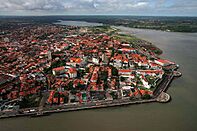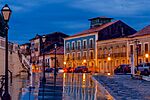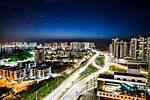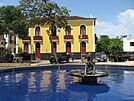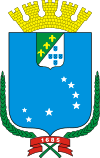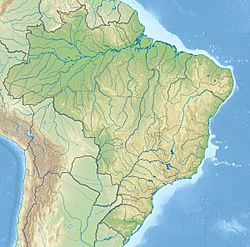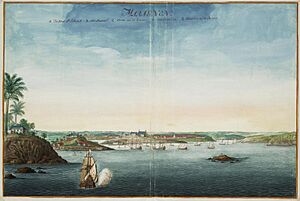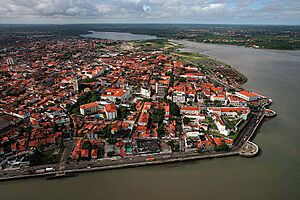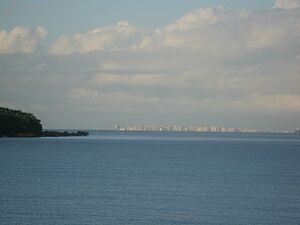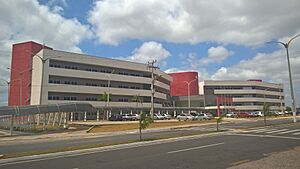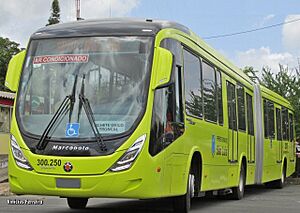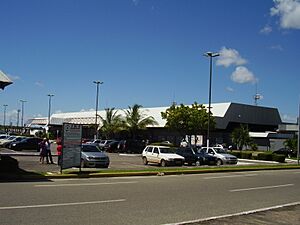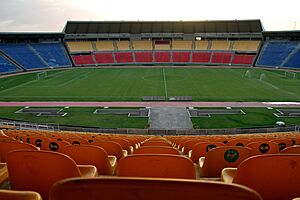São Luís, Maranhão facts for kids
Quick facts for kids
São Luís
|
|||
|---|---|---|---|
|
Municipality
|
|||
| Municipality of São Luís | |||
|
Aerial view, Leoes Palace, Cristo Rei Palace, Historical center, Ponta do Farol at night, Fountain in Pedro II Square and view of São Marcos Bay.
|
|||
|
|||
| Nickname(s):
Cidade dos Azulejos ("City of Tiles"), Jamaica Brasileira ("Brazilian Jamaica"), Ilha do Amor ("Love Island"), Ilha Magnética ("Magnetic Island")...
|
|||
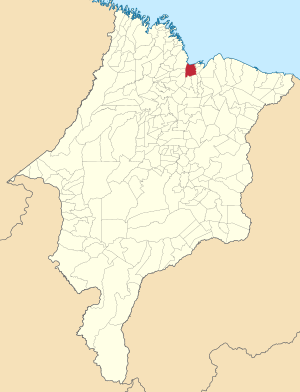
Location of São Luís
|
|||
| Country | |||
| Region | Northeast | ||
| State | |||
| Founded | September 8, 1612 | ||
| Named for | Saint Louis IX | ||
| Area | |||
| • Municipality | 827.141 km2 (319.360 sq mi) | ||
| Elevation | 4 m (12 ft) | ||
| Population
(2022)
|
|||
| • Municipality | 1,037,775 | ||
| • Density | 1,183.4/km2 (3,064.9/sq mi) | ||
| • Metro | 1,536,017 | ||
| Time zone | UTC-3 (UTC-3) | ||
| Postal Code |
65000-001 to 65109-999
|
||
| Area code | +55 98 | ||
| HDI (2010) | 0.768 – high | ||
São Luís (pronounced like "sown loo-EES") is the main city and capital of the Brazilian state of Maranhão. It is located on Upaon-açu Island, which is in Baía de São Marcos (Saint Mark's Bay). This bay is part of the Atlantic Ocean. Several rivers flow into it, including the Pindaré, Mearim, and Itapecuru.
São Luís has a very long coastline, stretching 640 kilometers (397 miles). About 1,037,775 people live in the city itself (based on the 2022 census). If you include the surrounding areas, the population is about 1,536,017. This makes it the 15th largest city in Brazil.
São Luís is special because it's the only Brazilian state capital founded by France. It was originally called Saint-Louis-de-Maragnan. It's also one of only three Brazilian state capitals located on islands. The city's old town, built in the 1600s, still has its original street layout. Because of this, UNESCO named it a World Heritage Site in 1997.
The city has two big sea ports: Madeira Port and Itaqui Port. These ports are important for shipping out iron ore from the Amazon region. São Luís also has major industries like metal processing with companies like Alumar and Vale. The Federal University of Maranhão is located here.
Many famous Brazilians come from São Luís. These include the samba singer Alcione and writers like Aluísio Azevedo and Ferreira Gullar.
Contents
History of São Luís
Long ago, São Luís was a large village of the Tupinambá tribe. The first Europeans to settle here were the French in 1612. They wanted to create a colony called Equinoctial France. They built a fort named Saint-Louis de Maragnan. This fort was named after King Louis XIII and his ancestor Louis IX, who was a saint. The city was officially founded on September 8.
However, Portugal took over the settlement in 1615 after a battle. They renamed the city São Luís. Since the French didn't have much time to build, some people debate if the French or Portuguese truly founded the city.
In 1641, the city was invaded by the Dutch. But they left Maranhão in 1644. In 1677, São Luís became the center of a new Catholic area.
After the invasions stopped, the government created the state of Grão-Pará e Maranhão. Its economy relied on farming, especially exporting sugar cane, cacao, and tobacco. There were conflicts among local leaders. One famous event was the Beckman's Revolt. This happened because of disagreements between religious groups and landowners. The situation led to a rebellion against the Portuguese. Brothers Manoel and Tomás Beckman led it. Portuguese troops eventually stopped the revolt. The Beckman brothers were arrested and executed. Manoel Beckman's last words were "By the Maranhão people I die happy." This phrase is now in the State Council Building.
When the American Civil War started, São Luís began supplying cotton to Great Britain. The money from this helped modernize the city. It also brought religious teachers and improved the water supply. São Luís became the third most populated city in Brazil. By the late 1800s, farming declined. Since then, people in the city have looked for other ways to earn a living.
Today, São Luís has the largest and best-preserved collection of old Portuguese buildings in Latin America. The island is known as the "Island of Love." It's also called "the Brazilian Athens" because many poets and writers, like Gonçalves Dias, came from here. The city is also known as "the Brazilian Jamaica" because Reggae music is very popular.
Economy of São Luís
Until the mid-1800s, Maranhão's economy was one of the best in Brazil. But after the American Civil War, the state lost its cotton export market. This caused a decline. It wasn't until the late 1960s that the state started to grow again. New roads and railways connected it to other regions.
In the late 1700s, there was a high demand for cotton in England. At the same time, cotton production in the United States was low due to the Revolutionary War. This was a great chance for Maranhão to produce cotton. Shipping companies started routes from São Luís to London. This helped export cotton from areas like Caxias. Even in the early 1900s, São Luís still exported cotton to England by sea.
During this successful time, São Luís had a lively culture. The city felt more like European capitals than other Brazilian cities. It was the first to host an Italian opera. It also received the latest French literature every week. Wealthy cotton producers sent their children to study in big Brazilian cities or even in Europe.
Today, São Luís has important ports. The Port of Ponta da Madeira is one of the deepest in the world. It is very busy. These ports are used for industrial goods and iron ore from the Carajás Railway. They also export soybeans grown in southern Maranhão. Being close to Europe and North America makes the port a good choice for shipping goods.
The economy of São Luís mainly relies on aluminum processing (by ALUMAR) and pelleting (by VALE). Food production and tourism are also important. São Luís has the highest GDP in the state. It has two public universities and many other schools.
Close by, in Alcântara, is the Alcântara Space Center.
Geography and Climate
São Luís is on Upaon-Açu Island. This island is between two large bay systems: São Marcos Bay to the west and São José Bay to the east. These bays are connected by narrow channels.
In São Marcos Bay, rivers like the Mearim flow in. In São José Bay, the Itapecuru and Munim rivers flow. The tides here can be very high, sometimes more than seven meters. The area has many small streams and tidal channels. The land has been shaped by weather, water, and strong winds. The plants include parts of the Amazonian Forest, Mangroves, and a large grassy plain called Campo de Perizes.
The climate is hot and semi-humid. It's a tropical climate with two main seasons. The wet season is from January to June, with lots of rain. The dry season is from July to December. On average, it rains about 2,200 mm (87 inches) each year. Most of the rain falls from February to May.
There are several protected natural areas on the island. These include the APA das Reentrancias Maranhenses and the Bacanga State Park.
Bridges connect Upaon-Açu Island to the mainland. These include the Marcelino Machado bridge (BR-135) and bridges for railways. There is also a ferry service between São Luís and Alcântara. The city is served by the São Luís International Airport.
Climate Details
São Luís has a tropical climate. It has a short dry season from August to November. During this time, it's warm to hot and sunny. The wet, rainy season lasts for most of the rest of the year, from January to June. During this time, there are many clouds and heavy rains. The cloudiest month is March, and the sunniest is August. April is the wettest month, and October is the driest.
| Climate data for São Luís (1991–2020 normals, extremes 1961–1990) | |||||||||||||
|---|---|---|---|---|---|---|---|---|---|---|---|---|---|
| Month | Jan | Feb | Mar | Apr | May | Jun | Jul | Aug | Sep | Oct | Nov | Dec | Year |
| Record high °C (°F) | 33.6 (92.5) |
36.0 (96.8) |
32.8 (91.0) |
33.0 (91.4) |
33.2 (91.8) |
33.1 (91.6) |
32.7 (90.9) |
34.4 (93.9) |
34.0 (93.2) |
33.2 (91.8) |
34.4 (93.9) |
33.8 (92.8) |
36.0 (96.8) |
| Mean daily maximum °C (°F) | 31.1 (88.0) |
30.6 (87.1) |
30.3 (86.5) |
30.6 (87.1) |
31.3 (88.3) |
31.5 (88.7) |
31.5 (88.7) |
32.0 (89.6) |
32.3 (90.1) |
32.5 (90.5) |
33.5 (92.3) |
32.2 (90.0) |
31.6 (88.9) |
| Mean daily minimum °C (°F) | 24.2 (75.6) |
24.0 (75.2) |
23.8 (74.8) |
23.8 (74.8) |
23.9 (75.0) |
23.5 (74.3) |
23.4 (74.1) |
24.7 (76.5) |
24.4 (75.9) |
24.7 (76.5) |
24.9 (76.8) |
25.0 (77.0) |
24.2 (75.5) |
| Record low °C (°F) | 20.0 (68.0) |
20.1 (68.2) |
17.9 (64.2) |
13.1 (55.6) |
20.2 (68.4) |
20.6 (69.1) |
18.1 (64.6) |
20.3 (68.5) |
20.9 (69.6) |
21.2 (70.2) |
21.6 (70.9) |
20.0 (68.0) |
13.1 (55.6) |
| Average precipitation mm (inches) | 235.4 (9.27) |
308.0 (12.13) |
452.8 (17.83) |
431.4 (16.98) |
312.0 (12.28) |
174.3 (6.86) |
110.8 (4.36) |
22.5 (0.89) |
2.9 (0.11) |
2.8 (0.11) |
9.7 (0.38) |
54.5 (2.15) |
2,117.1 (83.35) |
| Average precipitation days (≥ 1 mm) | 13 | 17 | 22 | 22 | 18 | 13 | 10 | 3 | 1 | 0 | 1 | 4 | 124 |
| Average relative humidity (%) | 82.5 | 84.8 | 86.6 | 87.7 | 86.4 | 84.3 | 82.1 | 80.5 | 77.6 | 76.2 | 76.6 | 77.6 | 81.9 |
| Average dew point °C (°F) | 24.2 (75.6) |
24.3 (75.7) |
24.4 (75.9) |
24.7 (76.5) |
24.8 (76.6) |
24.4 (75.9) |
24.2 (75.6) |
23.9 (75.0) |
23.6 (74.5) |
23.5 (74.3) |
23.7 (74.7) |
23.9 (75.0) |
24.1 (75.4) |
| Mean monthly sunshine hours | 155.9 | 119.2 | 115.3 | 120.2 | 163.5 | 201.6 | 233.3 | 267.5 | 258.3 | 264.2 | 235.1 | 215 | 2,349.1 |
| Mean daily daylight hours | 12.3 | 12.2 | 12.1 | 12.1 | 12 | 12 | 12 | 12 | 12.1 | 12.2 | 12.2 | 12.3 | 12.1 |
| Average ultraviolet index | 12 | 12 | 12 | 12 | 11 | 10 | 10 | 11 | 12 | 12 | 12 | 12 | 12 |
| Source 1: Instituto Nacional de Meteorologia | |||||||||||||
| Source 2: Weather atlas(Daylight-UV) | |||||||||||||
Education in São Luís
Portuguese is the main language taught in schools. English and Spanish are also part of the official high school lessons.
Some of the educational places in São Luís are:
- Universidade Federal do Maranhão (UFMA)
- Universidade Estadual do Maranhão (UEMA)
- Faculdade Santa Terezinha (CEST)
- Universidade Ceuma (UNICEUMA)
- Instituto Estadual de Educação, Ciência e Tecnologia do Maranhão (IEMA)
- Instituto Federal de Educação, Ciência e Tecnologia do Maranhão (IFMA)
- Faculdade São Luís
- Unidade de Ensino Superior Dom Bosco (UNDB)
- Faculdade Atenas Maranhense (FAMA)
- Faculdade do Maranhão (FACAM)
- Faculdade Pitágoras
Culture of São Luís
| UNESCO World Heritage Site | |
|---|---|
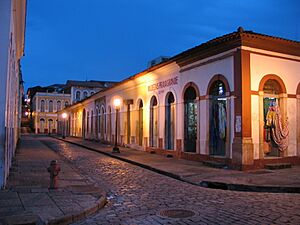 |
|
| Criteria | Cultural: iii, iv, v |
| Inscription | 1997 (21st Session) |
| Area | 66.65 ha |
São Luís is famous for its beautiful tiles. Many buildings in the old city center are covered in them. This is why the city is sometimes called "The Tiles City" or "Brazilian Athens."
The city also has unique cultural traditions:
Tambor de Crioula
Tambor de Crioula is an Afro-Brazilian dance. Women in colorful clothes dance around a group of drums called tambors. They spin and move to the music, trying to get the best spot in the center. There is a museum, the House of Tambor de Crioula, that helps keep this cultural dance alive.
Tambor de Mina
This is different from Tambor de Crioula. Tambor de Mina is a local Afro-Brazilian religion. The Casa das Minas (House of Minas) is the oldest temple for this religion. It was likely started in São Luís in the 1840s by African women.
Bumba Meu Boi
The Bumba Meu Boi is a popular musical play. It's like a big pantomime. People practice it after Easter, and it becomes a huge event in June. Hundreds of groups perform every night. It's a funny story with a deeper meaning about people living together. Characters like settlers, Indigenous people, and African slaves are part of the show. They use costumes, dance, and music. The audience sings and dances along. This festival celebrates the harvest, with a bull as its main symbol.
Capoeira
The style of capoeira in São Luís is thought to be similar to the older, traditional capoeira from Bahia.
Historic City Center
The Historic Center of São Luís was named a UNESCO World Heritage Site in 1997. It stands out because of its many sobrados (Portuguese townhouses). It also has the largest collection of outdoor azulejos (tiles) in Brazil. It's a rare example of a planned Portuguese colonial city in Brazil. Since 1989, there have been efforts to fix up and restore the old buildings. Important historic places include the Metropolitan Cathedral and the Ribeirão fountain.
Reggae Music
São Luís is known as the Brazilian capital of reggae music. This music style is very popular in the city. In 2018, the Reggae Museum of Maranhão was opened. It is the first museum dedicated to reggae outside of Jamaica.
Transportation in São Luís
The city has an airport called Marechal Cunha Machado International Airport.
There are many bus lines in the São Luís area. Over 3,000 buses serve more than 500,000 people daily. There are also many taxis available.
São Luís has one of Brazil's few inter-city train services. It connects São Luís with Parauapebas. This train carried 330,000 passengers in 2019.
The city has a port for boats that take passengers to the city of Alcântara. Another port handles ferries that carry people and cars to nearby cities.
Since São Luís is on an island, it has only one road connecting it to the mainland. This is the BR-135 bridge over the Estreito dos Mosquitos.
Telecommunications
The local phone code for São Luís is 98 (DDD98).
Sports in São Luís
Football is the most popular sport in São Luís. The main professional football clubs are:
- Sampaio Corrêa: Plays in Brazil's second division.
- Moto Club: Plays in the fourth division.
- Maranhão Atlético Clube: Plays in the regional Campeonato Maranhense.
Notable People from São Luís
- Aluísio de Azevedo (1857-1913), a Brazilian writer.
- Ana Paula Belo (born 1987), a Brazilian handball player who won a World Championship in 2013.
- Artur Azevedo (1855-1908), a Brazilian writer and poet.
- Alcione Nazareth (born 1947), a famous Brazilian singer.
- Clemer (born 1968), a former Brazilian professional football player.
- Rafael Leitão (born 1979), a Brazilian chess grandmaster.
- Zeca Baleiro (born 1966), a Brazilian singer.
Images for kids
See also
 In Spanish: São Luís para niños
In Spanish: São Luís para niños


